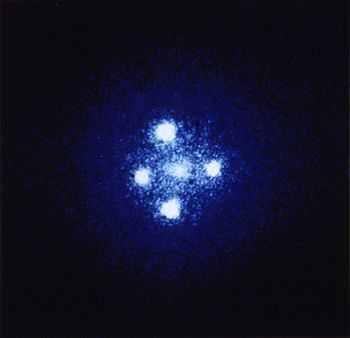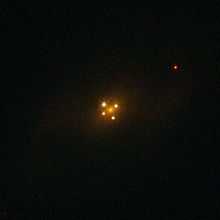Einstein Cross
| QSO 2237+0305 | |
|---|---|
 | |
| Observation data (Epoch J2000) | |
| Constellation | Pegasus |
| Right ascension | 22h 40m 31s |
| Declination | +3° 21′ 30.3″ |
| Redshift | 1.695 |
| Distance | 8,000,000,000 ly (2,500,000,000 pc) |
| Type | LeQ |
| Apparent dimensions (V) | less than 2" |
| Apparent magnitude (V) | 16.78 |
| Other designations | |
| LEDA 69457, Z 378-15 | |
| See also: Quasar, List of quasars | |
The Einstein Cross or Q2237+030 or QSO 2237+0305 is a gravitationally lensed quasar that sits directly behind ZW 2237+030, Huchra's Lens. Four images of the same distant quasar appear around a foreground galaxy due to strong gravitational lensing.
According to current interpretations of redshift, the quasar is located about 8 billion light years from Earth, while the lensing galaxy is located at a distance of 400 million light years.[1] The apparent dimension of this galaxy is 0.87x0.34 arcminutes, while the apparent dimension of the cross in its center accounts for only 1.6x1.6 arcseconds.
The Einstein Cross can be found in Pegasus at 22h40m30.3s +3d21m31s.
Amateur astronomers are able to see some of the cross using telescopes but it requires extremely dark skies and telescope mirrors with diameters of 18 inches or greater.[2]
The individual images are labelled A through D (i.e. QSO 2237+0305 A), the lensing galaxy is sometimes referred to as QSO 2237+0305 G.

See also
- Einstein ring (Chwolson ring)
- Gravitational lensing
- Quasar
- Cloverleaf Quasar
- Twin Quasar
References
- ↑ NASA and ESA (September 13, 1990). "The Gravitational Lens G2237 + 0305". HubbleSite. Retrieved July 25, 2006.
- ↑ Crinklaw, Greg. "Focus on Einstein's Cross". Retrieved 2013-06-29.
External links
- Information about Einstein's Cross on Skyhound.com
- Einstein's Cross core
- Einstein's Cross by Jay Reynolds Freeman
- Photo of the Einstein Cross at Astronomy Picture of the Day (March 11, 2007)
- Google Sky
Coordinates: ![]() 22h 40m 31.0s, +03° 21′ 30.3″
22h 40m 31.0s, +03° 21′ 30.3″